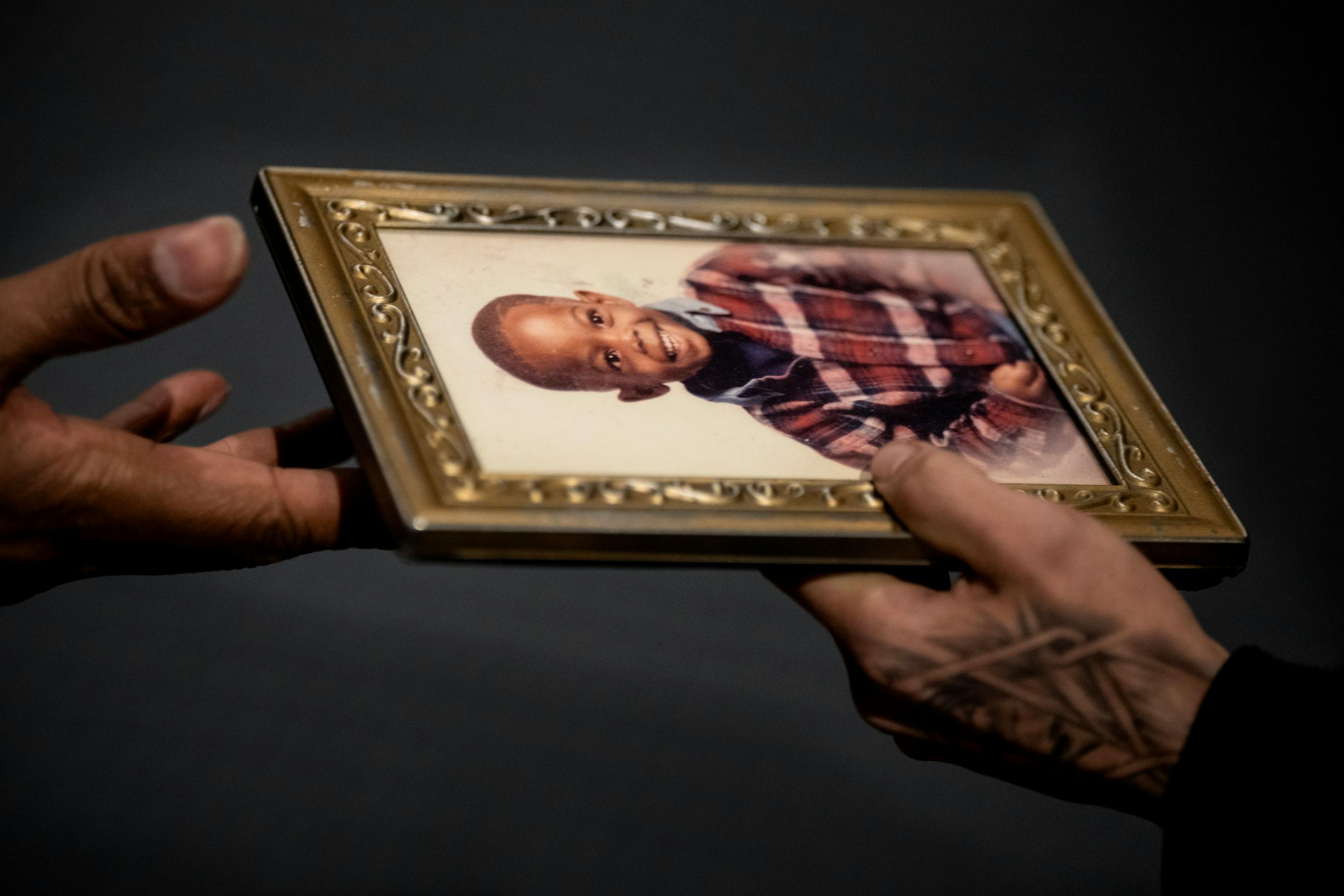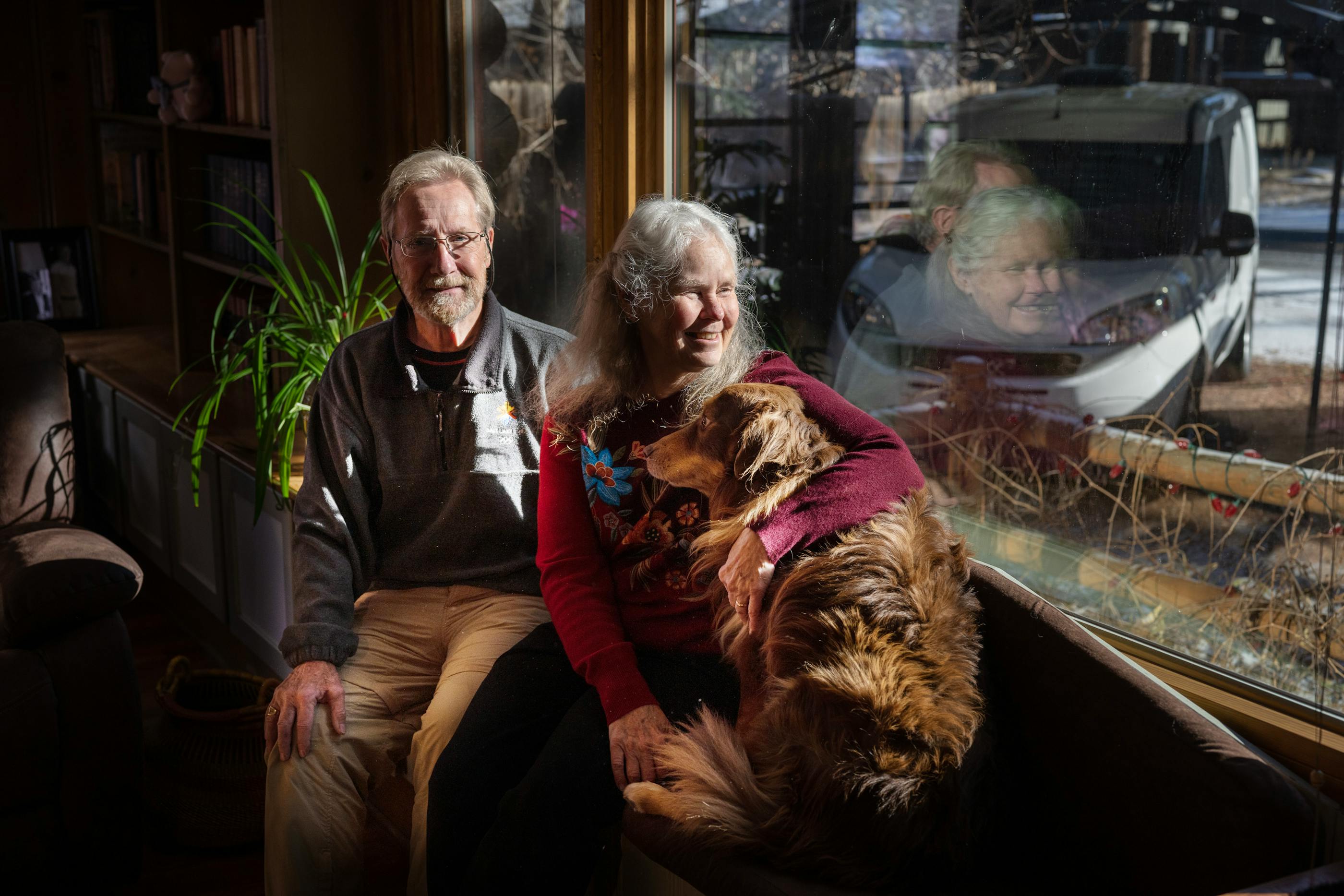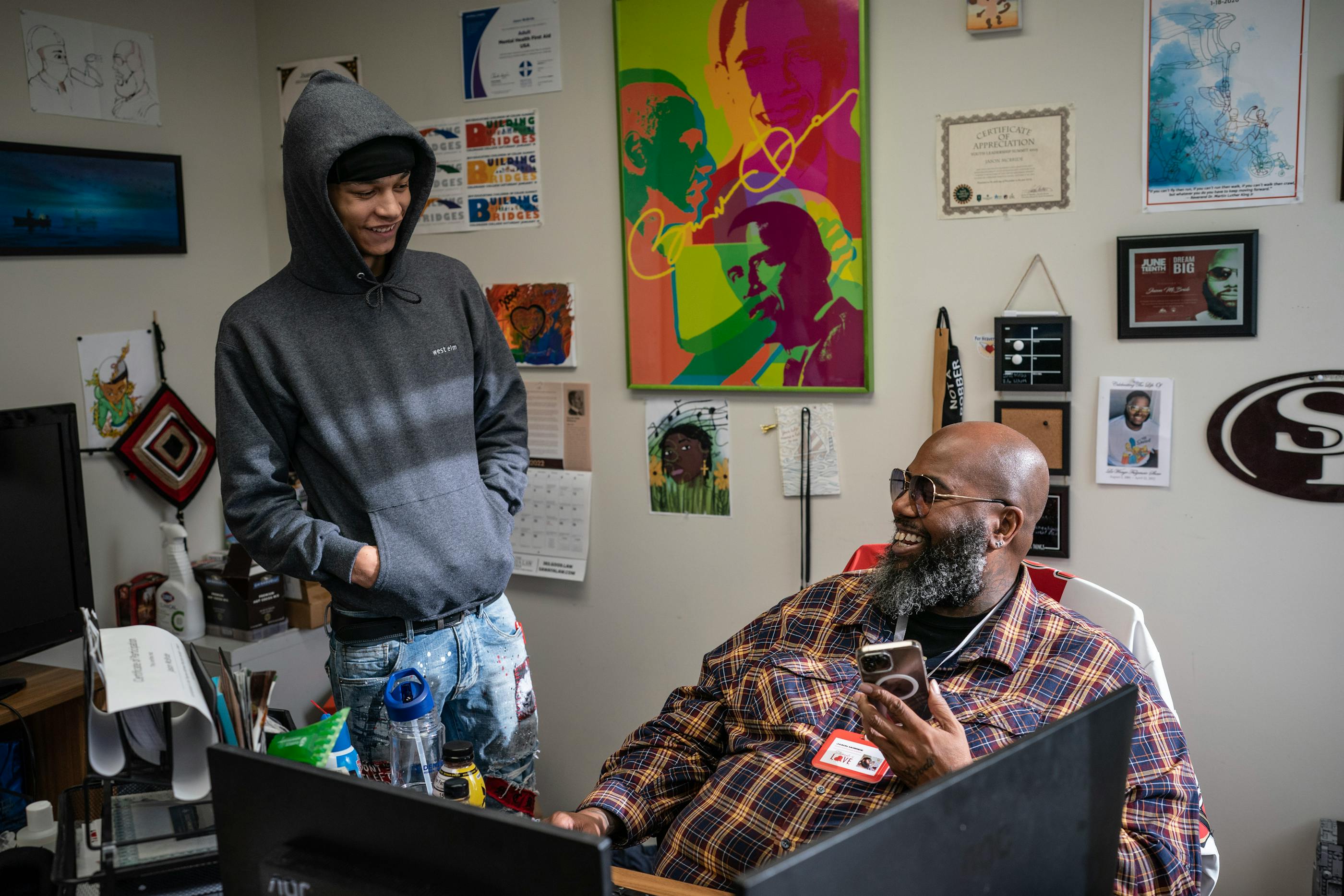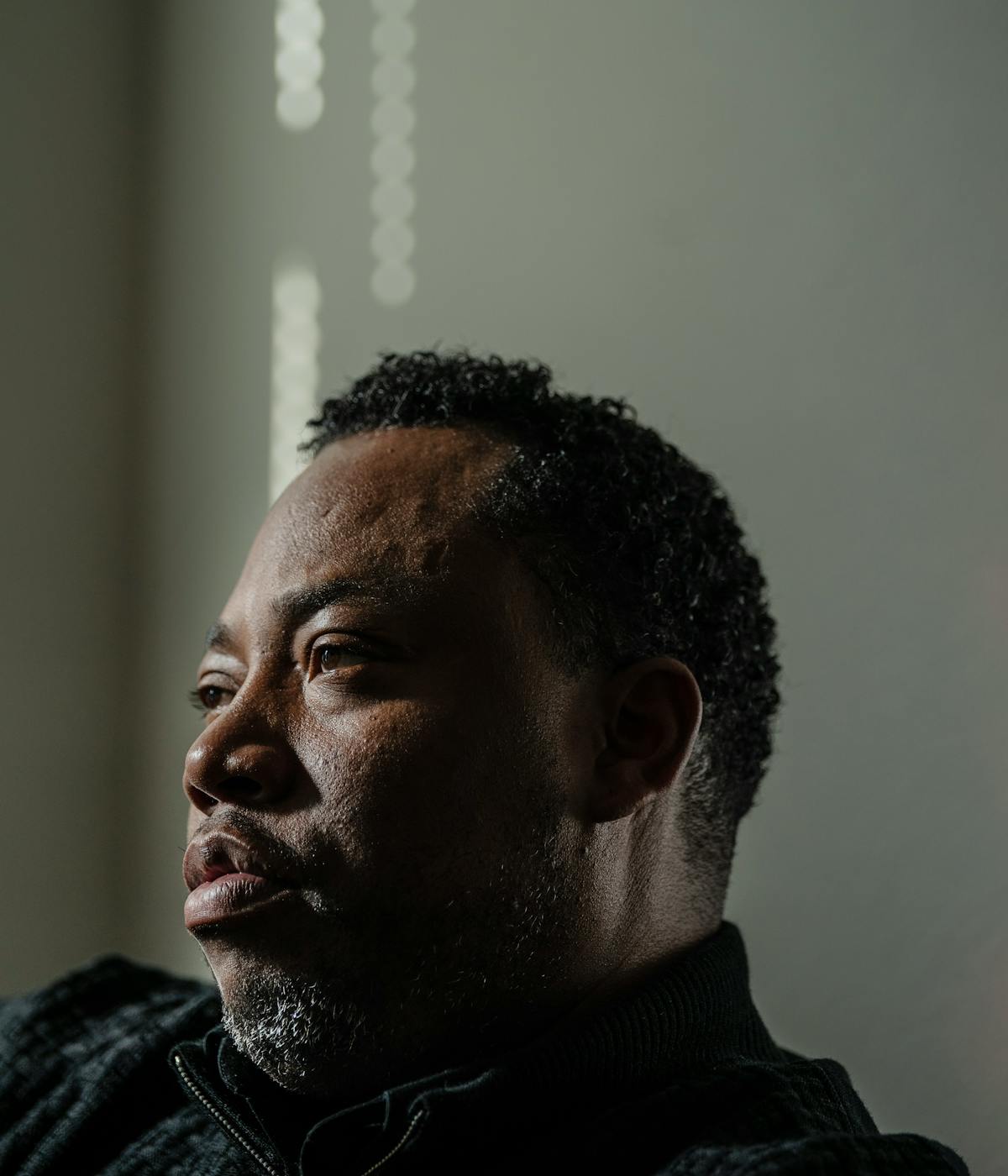Denver, Colo.
Six teenage boys dressed in hoodies and wearing ankle monitors sat in silence as they passed around a photograph of a 3-year-old named Casson, who was killed in the crossfire of a gang shootout 27 years ago.
The photo of the toddler made its way back to the boy's mother, Sharletta Evans. She described the final, agonizing moments of Casson's life, of crying out for help as she cradled her bleeding son in her arms.
"Tonight, the mother in me is rising up, because I hear too many of you making excuses," Evans said. "You have to understand that children are dying, that my beautiful baby boy is never coming back, and your life is at risk because of your choices."
The impassioned plea from a grieving mother exemplifies one way the state of Colorado has emerged as the nation's foremost laboratory for juvenile justice reform, passing more laws supporting alternatives to prosecution and detention than any other state.
In Denver, teenagers caught with guns are being channeled through an intensive, six-week program in which they sit face-to-face with victims who like Evans have lost loved ones to gun violence. Forty miles north in Boulder, children who commit higher-level crimes are assigned social workers who help them access mental health services. And in Fort Collins, youths who commit crimes are encouraged to come up with their own ideas for repairing harm — from volunteering at schools to planting gardens.
If these teens had committed similar crimes in Minnesota, they likely would be consigned to overwhelmed juvenile courts and probation departments — a system that is failing to deliver on its promise of rehabilitating troubled youths.
"To sit down across the table from someone whom you've harmed and work to make a repair is infinitely more difficult than to stand in front of the judge and say nothing," said Luke Yoder, executive director of a restorative justice nonprofit in Alamosa County in southern Colorado.
In Minnesota, as in much of the country, alternative approaches to handling youth crimes — such as victim-offender dialogues and community service — have been slow to gain public support. Minnesota has no uniform standards for who can participate in restorative justice programs, no guidelines about what the programs should include, and little insight into whether they are working because outcomes like recidivism are not consistently tracked. Even promising programs have shuttered due to unstable funding or shifting political winds.
These shortcomings have undermined public confidence in restorative programs in Minnesota and created the perception that they are soft on crime.
But Colorado has overcome these obstacles through a series of hard-won legislative victories and a commitment to measuring outcomes.
Statewide, more than 1,300 youths in Colorado have been sent to restorative justice programs over the past seven years. Fewer than one in 10 committed another crime within a year after completion, according to a state study. By comparison, the reoffense rate for youths placed on juvenile probation in Colorado is 16%, and nearly 50% for adults coming out of the state's prisons.
These alternative approaches are typically more rigorous than sentences meted out by juvenile court judges, according to legal scholars and attorneys who participate in them. As a result, the programs have taken hold even in Colorado's conservative ranch country — known for its tough-on-crime prosecutors.
"Colorado has dispelled the myth that these are just 'hug a thug' programs," said Anne Teigen, program director for juvenile justice at the National Conference of State Legislatures. "Restorative justice [in Colorado] is quite an intensive and rigorous process, and it's not as simple as what many people think."
Yet even here, there is growing unease with the policies. A rash of gun violence, including gang shoutouts in Denver and a shooting rampage last month that killed five and wounded dozens at an LGBTQ nightclub in Colorado Springs, is stirring calls for tougher measures.
Even community leaders who support restorative programs are openly questioning whether they go far enough in addressing the root causes of teen violence.
"We have plenty of data showing that restorative justice works, but sometimes it feels like we're putting a Band-Aid on an open heart wound," said Liz Porter-Merrill, a public defender who serves on a state council that oversees restorative justice programs.

'Face to face, mano a mano'
Colorado state Sen. Pete Lee's initial exposure to a restorative justice program occurred almost two decades ago while volunteering for a Colorado Springs nonprofit that employed youths charged with theft and other property crimes. Instead of being prosecuted in court, the kids would pay off the damage caused by their crimes through physical labor. The teens hand-delivered the money they earned to their victims.
Youths who participated in the program, known as Workout Ltd., returned more than $2 million to crime victims around Colorado Springs. More than 90% of the youth participants did not commit another crime.
"It was hard work, difficult work," said Lee. "The fact that the kids had to deliver those checks directly to the victims — face to face, mano a mano — made all the difference. … They learned empathy and the impact their choices had on victims."
For Lee, a Democrat who prides himself on working across the aisle, the experience inspired him to become the state's most visible champion for alternatives to criminal prosecution.
As a rookie legislator in 2010, he began drafting bills that transformed the state's juvenile system. Colorado became the only state to establish a state council to oversee restorative justice programs and track outcomes. Victims played a pivotal role in the legislative process; state law now requires victims to be informed of restorative justice practices. To help fund the restorative programs, the state created a $10 fee levied against Coloradans convicted of crimes.
The early success of the approach helped break down opposition from conservative skeptics.
In 2013, the state created a pilot program that established restorative justice programs in four judicial districts in the state, from rural Alamosa County in the south to Boulder. At each site, youths arrested for first-time offenses were given the opportunity to participate in dialogues with victims and community members. The results were stark: Juvenile court cases fell by 15% or more in some districts, while the reoffense rate for kids who participated was just 8.2%, according to a 2020 study.
As he pressed the case for reform, Lee learned how to tailor his message to Coloradans of varying political stripes and ideologies, including local police and prosecutors.
"To the fiscal conservatives, I emphasized cost savings," Lee said. "To the moral conservatives, I emphasized individual responsibility and accountability. To the law and order set, I spoke about enhanced public safety and reduced recidivism. And to the victim advocates, I talked about respect and the beginning of healing."

The appeals worked. By 2018, the Colorado General Assembly would enact more than 40 changes to state law supporting restorative justice — the most in the country.
Colorado's embrace of restorative justice practices isn't limited to the courtroom. Programs now stretch into every part of the juvenile justice system, reaching even those incarcerated for serious crimes.
The Division of Youth Services (DYS), which operates 15 secure facilities for minors around the state, employs a restorative justice coordinator to help identify service projects on and off campus for kids committed to their care.
"We're really always trying to get them to understand the impact they have on the community," said DYS Director Anders Jacobson, "and why bettering themselves and giving back is a way to help … repair the tear of the fabric, if you will."
Since taking over the agency in 2016, Jacobson has drastically reduced the use of mechanical restraints and seclusion, and transformed the physical spaces inside youth centers. Facility walls, once sterile and white, now pop with vibrant colors and student artwork. Prison-issue couches and metal beds were swapped for softer furniture that mimics a home environment. And a new dress code eliminated jail scrubs, instead outfitting teens in khakis and polo shirts.
"When you introduce a youth into a correctional-feeling atmosphere, generally speaking, that's how they're going to behave," Jacobson said. The results were promising: One-year post-discharge recidivism rates for youth dropped by nearly a third in 2020 from the 10-year average of 31%.

A chance to make amends
It was late morning, and strong winds were gusting off the Flatiron Mountains near Boulder, when a slender college student walked through the front doors of the Boulder County District Attorney's Office.
The 20-year-old, who declined to share his name, appeared anxious. On a night months earlier, he got dangerously drunk and wandered into a stranger's home near the University of Colorado campus in Boulder. Terrified that the young man might attack his family, the homeowner called 911, and the student was taken away as he yelled obscenities at the police.
Anywhere else, he would probably have faced serious charges — including trespassing, resisting arrest and disorderly conduct — that would become a permanent part of his criminal record, making it more difficult to find work and housing.
But on this December morning, he had a chance to make amends outside the courtroom.
He met with two trained facilitators, an older community member and a Boulder police officer connected via video monitor. As the student took his seat, a Labrador retriever named Buck — trained to comfort people under stress — nestled his head on the young man's lap.
Over the next hour, he grew teary-eyed as he spoke of the severity of his actions, acknowledging that a different homeowner could have shot him. There was debate about what he should do to repair the harm. Eventually, he agreed to write apology letters to everyone involved and signed an agreement committing to show responsible alcohol use.
It was the sort of frank exchange that seldom occurs in a juvenile courtroom, where youths are typically instructed to stay silent while attorneys and judges debate their punishments, noted Lalenia Aweida, a restorative justice practitioner and co-facilitator of the meeting. "When we bring people together like this in a healing environment, it can be magic," she said.
No place in Colorado has embraced restorative justice more openly than Boulder County. Reform-minded officials from Boston, Kansas City and New Orleans have traveled to this scenic university town to learn how restorative dialogues can keep troubled kids from reoffending. Boulder County diverts more than 200 juvenile cases a year, or more than half of all juvenile cases, and recidivism rates are consistently less than 10% — even for felony-level crimes.
Michael Dougherty, Boulder County's district attorney, said his support for the approach stems in part from his 13 years as a prosecutor with the Manhattan District Attorney's Office in New York.
At criminal arraignments, when defendants are charged and bail is set, Dougherty was shocked that defendants sometimes had up to 100 prior convictions — and no effort was made to offer them mental health or substance use services to keep them out of the criminal system. "As a young prosecutor, I kept thinking, why are we not doing more on the front end?" Dougherty said. "I could tell the system was not working and this person was going to come back. ... Here, we're catching people further upstream."

Outpaced by gun violence
Despite the spread of restorative justice programs in Colorado, the high hopes that surrounded them have been tempered by a sharp rise in shootings involving teenagers.
The number of Denver youths charged with gun possession has increased 44% over the past six years, including more than 300 such charges since the start of 2020.
In an effort to stop the cycle of shootings, the Denver District Attorney's Office last August launched a program that seeks to steer youths away from gun crimes. Teens caught with guns can avoid criminal sanctions if they attend six weeks of educational sessions with their parents, including panels with victims of gun violence and emergency room doctors who treat gunshot victims. So far, just three of the 31 youths who have been through the program have reoffended.
In a recent interview, Denver District Attorney Beth McCann expressed exasperation at the rash of youth shootings, while acknowledging that restorative programs have not kept pace with the rising violence. "I am so tired of meeting with parents of a child who's been killed for some stupid thing, like they got in an argument," she said.
Jason McBride is a former member of the Bloods street gang who now runs a nonprofit, known as the Struggle of Love Foundation, that mentors inner-city youth and seeks to keep them from joining gangs.
On a recent afternoon, McBride leaned his giant frame in his chair and tried not to cry. But the tears flowed as he rattled off the names of 16 teenagers who were part of his caseload who have been killed by gun violence over the past six years.
"Restorative justice is necessary and important, but they are a drop in the bucket," he said. "We need far more of these programs to meet the need."
As McBride spoke, a volunteer popped his head into his office and said "shots were fired" at nearby George Washington High School. McBride debated whether to rush to the site to talk to the teenagers, but the culprits had already scattered.
"Every year, people come to me at the start of the summer and they ask, 'How bad is the gun violence going to get?'" McBride said. "And I tell them, this summer is gonna be worse than the previous summer, which was worse than the summer before that, which was the worst summer of violence we ever had. It's gotten to the point where I honestly don't know how we're going to stop it."

A mother's love
On a brisk autumn afternoon in 2021, Raymond Johnson, the man who killed 3-year-old Casson, walked out of prison after 26 years behind bars.
One of his first calls was to Evans, Casson's mother, who had written to him while he was at the Four Mile prison in southern Colorado.
Johnson, now 43, met Evans that day to discuss ways he could begin to repair the anguish he caused on Dec. 21, 1995, when he sprayed seven bullets at a rival gang, inadvertently striking Casson while he was in the back seat of his mother's car.
"We both knew that we couldn't bring back her baby's life," Johnson said, "but I would work every day to heal the wound."
Today, Johnson and Evans appear together at restorative justice dialogues. They have dinner at each other's homes. They attend Sunday worship services together.
Their bond is now so deep that Evans refers to Casson's killer as her "adopted son."
"So when you wonder, what is this restorative justice all about?" asked Evans, pausing to gaze at the six teen boys gathered around her. "The message is that life is valuable and you have to care about every single breath you breathe."

About this series
Juvenile Injustice is a Star Tribune special report examining how Minnesota's juvenile justice system is failing young people, families and victims of violence.
Part 1: Broken promises, shattered lives
The consequences can be
deadly when the juvenile
system fails to intervene in the lives of Minnesota's most troubled kids.
Part 2: Justice 'by ZIP code, not fairness'
Minnesota has no
uniform standards for who can
join diversion programs or what they offer.
Part 3: Nowhere to go for most troubled youth
As youth detention
centers close, Minnesota runs out of places to
rehabilitate kids who commit serious crimes.
Part 4: 'Back door to prison' steals precious time
Minor offenses often funnel Minnesota youth from extended probation into adult lockup.
Part 5: Laying down the law for youths
Minnesota's juvenile justice system is broken. Colorado shows how it could be better.
How we reported these stories
Star Tribune journalists spent more than a year examining hundreds of juvenile court cases dating back to 2018 that involved violent crimes, including shootings, aggravated robberies and homicides. Many of the young people charged in those incidents had committed previous offenses, leading us to ask whether Minnesota's juvenile justice system was fulfilling its core promise of rehabilitating youth while protecting public safety.
Our review of court records was limited in scope because most juvenile case records are confidential. In Minnesota, juvenile crime records are only accessible to the public if the offense is a felony and the youth was at least 16. In cases where a court document was not accessible, we relied on interviews and documents obtained from relatives, victims and public-records requests from local law enforcement agencies.
Gathering statewide data about the effectiveness of rehabilitation efforts is difficult because the youth justice system in Minnesota is highly fragmented. The programs and the process of redirecting youth from formal judicial processing (known as "diversion") vary widely between counties. To better understand how these programs work, we created a survey that was sent to all 87 counties. We received responses from programs in more than half of those counties, representing 85% of the state's juvenile population.
Many young people do not re-offend. The juvenile courts shield their identities because a public record of their crime could be a barrier to attending college, obtaining a job or renting an apartment. Through the course of this series, we identify minors only by a first name — and only when parents have specifically consented. Those publicly identified after their deaths are the lone exception to this rule.
Series credits
Reporting: Liz Sawyer, Chris Serres, MaryJo Webster and Maya Miller
Photography and video: Jerry Holt, Mark Vancleave, Cheryl Diaz Meyer, Christine Nguyen and Deb Pastner
Design and development: Bryan Brussee, Josh Penrod, Jamie Hutt, Josh Jones and Dave Braunger
Graphics: C.J. Sinner, Eddie Thomas, MaryJo Webster and Josh Jones
Editing: Eric Wieffering and Abby Simons
Copy editing: Catherine Preus and Amy Kuebelbeck
Audience engagement: Anna Ta, Nancy Yang, Ash Miller and Tom Horgen
Share your story
The Star Tribune is continuing to report on Minnesota's juvenile justice system. We would like to hear from judges, prosecutors, young people who have been involved in the juvenile justice system and their parents, and victims of crimes. Our reporters will not share your information without your explicit permission. You can reach Liz Sawyer at 612-673-4648 or at liz.sawyer@startribune.com, or via the encrypted messaging app Signal at 612-916-1443. Chris Serres is at 612-673-4308 or chris.serres@startribune.com, or on Signal at 612-910-7134.

